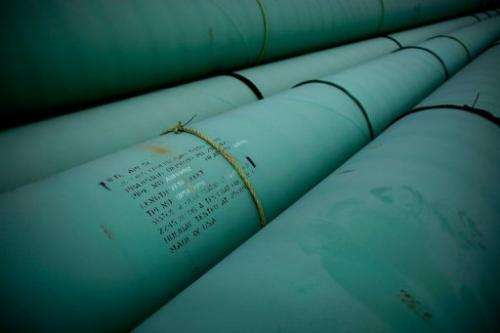Pipe is stacked at the southern site of the Keystone pipeline on March 22, 2012 in Cushing, Oklahoma. The controversial pipeline passed another hurdle Tuesday after the governor of Nebraska approved a new route that will avoid environmentally sensitive areas like the state's Sand Hills.
The controversial Keystone pipeline passed another hurdle Tuesday after the governor of Nebraska approved a new route that will avoid environmentally sensitive areas like the state's Sand Hills.
President Barack Obama denied approval for the $7 billion pipeline last year out of environmental concerns.
The US State Department is currently reviewing the company's revised application for a permit to proceed with the 1,179-mile Keystone XL pipeline from Hardisty, Alberta to Steele City, Nebraska and is expected to announce a decision early this year.
Governor Dave Heineman noted in a letter to Obama that construction of the pipeline would bring his state $418.1 million in economic benefits and result in $11 to $13 million a year in additional property taxes.
The pipeline operator will also be responsible for developing an emergency response plan to deal with a potential spill and take out $200 million in liability insurance to cover its financial responsibilities in case of a spill, Heineman noted.
"Construction and operation of the proposed Keystone XL pipeline, with the mitigations and commitments from Keystone, would have minimal environmental impacts on Nebraska," Heineman wrote.
TransCanada began work in August on a 485-mile pipeline between Oklahoma and the Texas coast that does not require US presidential approval.
Canada is already the largest energy exporter to the United States. The Keystone XL pipeline would bring 830,000 barrels of oil per day to the Gulf Coast.
Environmentalists fear an accident would spell disaster for aquifers in central US Great Plains states.
They also oppose the project because exploiting the oil sands requires energy that generate a large volume of greenhouse gases and say a change of the route will not lessen the pipeline's dangers.
(c) 2013 AFP
























